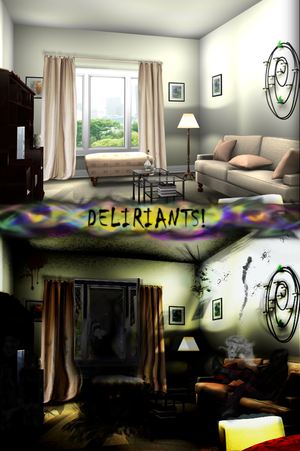Deliriant

Deliriant use is associated with highly uncomfortable and/or dangerous experiences.
Deliriants are highly unpredictable and may result in erratic behaviors, self-injury, hospitalization, or death. It should be noted that most individuals do not choose to repeat the experience due to its unpleasant nature.
Please use harm reduction practices if using this substance (e.g. starting with a low dose and always having a trip sitter). Refer to this section for more details.

Deliriants are a subclass of hallucinogens. They display a unique property in that they easily produce solid hallucinations which integrate seamlessly into waking consciousness, similar to fully formed dreams or delusions. In contrast, classical psychedelics and dissociatives have progressive levels of multiple all-encompassing sensory effects before reaching the level of concrete hallucination.
The term deliriant was introduced by David F. Duncan and Robert S. Gold to distinguish these substances from psychedelics and dissociatives, due to their primary effect of causing delirium (as opposed to the more lucid states produced by other types of hallucinogens).[1] The term is generally used to refer to anticholinergic drugs.
Despite the fully legal status of several common deliriant plants and substances, they are not popular as recreational substances due to the severe and unpleasant nature of the hallucinations they produce.[2]
In addition to their potentially dangerous mental effects (accidents during deliriant experiences are common),[3] certain deliriants are poisonous and can cause death due to tachycardia-induced heart failure and hyperthermia even in small doses.[4]
Use and experimentation with deliriants is generally discouraged due to their questionable safety profile. It is highly advised to use harm reduction practices if using these substances.
Method of action
Deliriants work via anticholinergic activity and their antagonistic action on acetylcholine receptors. Inhibition through this mechanism leads to decreased levels of acetylcholine, causing delirium, sedation, tachycardia and intensely realistic hallucinations. However, the precise role of these interactions and how they result in the deliriant experience continues to remain elusive.
It is theorized that cholinergics (such as racetams) can provide relief from the mechanisms of anticholinergics,[5] such as reversing their amnesiatic and psychosis-inducing effects. This is possible by restoring sufficient concentrations of acetylcholine.[6][7]
In contrast, cannabis and caffeine have a reverse effect by inhibiting acetylcholinesterase, an enzyme responsible for the breakdown of acetylcholine. This leads to increased levels of acetylcholine, and, in turn, improved cognition and stimulation; as a result, both cannabis and caffeine have an inhibitory effect on deliriants.
Subjective effects
Disclaimer: The effects listed below cite the Subjective Effect Index (SEI), an open research literature based on anecdotal user reports and the personal analyses of PsychonautWiki contributors. As a result, they should be viewed with a healthy degree of skepticism.
It is also worth noting that these effects will not necessarily occur in a predictable or reliable manner, although higher doses are more liable to induce the full spectrum of effects. Likewise, adverse effects become increasingly likely with higher doses and may include addiction, severe injury, or death ☠.
Visual effects
-
Suppressions
-
Distortions
-
Hallucinatory states
- Autonomous entities
- Scenarios and plots
- Settings, sceneries, and landscapes
- Shadow people
- Transformations
- Unspeakable horrors
External hallucinations
In comparison to other classes of hallucinogen, this effect occurs more frequently than that of any other at moderate to heavy dosages and is the defining feature of the experience.It can be comprehensively described through its variations as delirious in believability, interactive in style, equal in new experiences and memory replays in content, autonomous in controllability and solid in style.
The most common themes for these hallucinations include those of both everyday occurrences such as smoking phantom cigarettes, talking to people who are not there, insects and sinister, nightmarish experiences.
Internal hallucinations
In comparison to other classes of hallucinogen, this effect occurs briefly and spontaneously at moderate dosages but becomes progressively extended in its occurrence and duration proportional to dosage before eventually becoming all-encompassing.It can be comprehensively described through its variations as delirious in believability, interactive in style, equal in new experiences and memory replays in content, autonomous in controllability and solid in style.
Physical effects
-
Enhancements
-
Suppressions
-
Novel effects
-
Uncomfortable effects
Multisensory effects
Cognitive effects
-
Enhancements
-
Suppressions
-
Novel states
Auditory effects
Pharmacological classes
Examples
-
Tropane alkaloids
-
Antihistamines
-
Others
-
Plants and Entheogens
See also
References
- ↑ Duncan, D., Gold, R. (1982). Drugs and the Whole Person. John Wiley and Sons. ISBN 9780471041207.
- ↑ Grinspoon, L., Bakalar, J. B. (1997). Psychedelic Drugs Reconsidered. Lindesmith Center. ISBN 9780964156852.
- ↑ Datura Items | http://www.lycaeum.org/mv/mu/datura.html
- ↑ Beaver, K. M., Gavin, T. J. (September 1998). "Treatment of acute anticholinergic poisoning with physostigmine". The American Journal of Emergency Medicine. 16 (5): 505–507. doi:10.1016/S0735-6757(98)90003-1. ISSN 0735-6757.
- ↑ Wesnes, K., Anand, R., Simpson, P., Christmas, L. (January 1990). "The use of a scopolamine model to study the potential nootropic effects of aniracetam and piracetam in healthy volunteers". Journal of Psychopharmacology (Oxford, England). 4 (4): 219–232. doi:10.1177/026988119000400406. ISSN 0269-8811.
- ↑ Piercey, M. F., Vogelsang, G. D., Franklin, S. R., Tang, A. H. (20 October 1987). "Reversal of scopolamine-induced amnesia and alterations in energy metabolism by the nootropic piracetam: implications regarding identification of brain structures involved in consolidation of memory traces". Brain Research. 424 (1): 1–9. doi:10.1016/0006-8993(87)91186-3. ISSN 0006-8993.
- ↑ Preda, L., Alberoni, M., Bressi, S., Cattaneo, C., Parini, J., Canal, N., Franceschi, M. (1993). "Effects of acute doses of oxiracetam in the scopolamine model of human amnesia". Psychopharmacology. 110 (4): 421–426. doi:10.1007/BF02244648. ISSN 0033-3158.